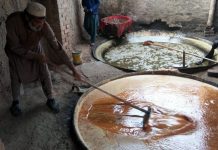Lahore: Textile industry in Punjab is in dire straits because of power shortages, government inaction and a flood of imports from China and India.
The industry is underperforming and energy crisis is the mother of all issues. Depreciation of the Pakistani rupee has significantly raised the cost of imported inputs followed by persistent rise in inflation and high borrowing cost as compared to rivals India and China have dealt serious blows to the textile as well as garment industries. It is also spending more on production than industrial sectors in other three provinces and industrialists are mulling closing down their businesses.
Law and order problems have forced buyers to abstain from visiting Pakistan. Similarly, local exporters are also unable to travel abroad for effective marketing of their products. Heavy duties on import of textile raw material forces garment makers to use cotton as core input, said Naseer Malik, Vice-Chairman of the Pakistan Readymade Garments Manufacturers and Exporters Association.
He said Pakistan is the eighth largest exporter of textile products in Asia. This sector contributes 9.5% to the GDP and shares around 57% of total exports.
The textile industry is believed to be the backbone of Pakistan’s economy as it is the biggest buyer of locally produced cotton. It provides direct and indirect employment to around 15 million or 42% workforce in the country. It contributed around $13.8 million to total exports in the year 2013-14. Punjab has the biggest share in the textile sector and around 70% of the textile industry is based in Punjab and Faisalabad is believed to be the hub. The energy constraints have hit Punjab industry the most and its entire textile chain has been affected. Some textile millers told NewsLens Pakistan around 30% of the textile industry in Punjab has ground to a halt and they fear more closures on a permanent basis if the situation remains the same. They said it increasingly becomes unviable for them to continue their operations by curtailing shifts, as Punjab textile industries have been designed to operate round-the-clock by default.
There is no round-the-clock power supply for Punjab’s textile industry and units run on cheap electricity generated by CPPs using natural gas. When gas supply is scarce, alternatives are used that result in increasing the cost of business for the industry, said Seith Akbar, Chairman of the All Pakistan Textile Mills Association (APTMA) Punjab Chapter, while talking to NewsLens Pakistan. The textile industry of Sindh and Khyber Pakhtunkhwa are getting round-the-clock gas supplies which make their products cheaper than Punjab, he said.
“This is the main reason for Punjab lagging behind Sindh. The millers in Sindh owing to low cost of business can easily bid for international orders whereas we (Punjab textile millers) cannot afford to bid at prices that Sindh offers because we are bearing other costs too”, he said, adding if issues are not addressed then Pakistan may not get full benefit of Generalized System of Preferences (GSP) plus status.
The Punjab produces all sorts of textile products for exports and local consumption. Influx of cheap import of clothing and fiber costs Pakistan around $7 billion, the APTMA said, adding strengthening domestic commerce will enable textile industry to produce additional 7Kg/capita valuing $7 billion for domestic consumption. Currently Pakistan’s total fiber/yarn production, including imported cotton and man-made fiber is 3,032 million Kg. Of the total fiber/yarn used in textile products for exports is 2,528 million Kg. Fiber yarn consumed by domestic market is 504 million Kg whereas official clothing imports for domestic consumption is 252 million Kg along with worn clothing imports for domestic consumption which stands at 403 million Kg. Informal textile and clothing trade from China and to some extend from India is calculated at 640 million Kg. These figures are compiled by APTMA and it is widely believed that the major chunk of imports has been under-invoiced owing to a weak documentation system in the country.
After the passage of 18th Amendment in 2009, which gives the right to a province to use its natural resources according to demand before passing the surplus to other provinces, the situation started deteriorating for the Punjab textile industry. That was the time when energy crises hit the country and electricity shortfall was at its peak. Since several textile industries were using natural gas for their Captive Power Plants (CPPs) to generate cheap electricity for commercial use, scarcity of gas became a serious concern for them.
According to utility companies, the rate of electricity tariff for industries is Rs 18 per unit whereas gas tariff for a CPP is $6/MMBTU. A CPP can generate electricity via gas at a cost of Rs 5 per unit. The textile mills in Sindh and KPK get round-the-clock gas supplies under the 18th Constitutional Amendment whereas the Punjab industry is faced with massive load management both for gas and electricity.
The data compiled by APTMA suggests that Punjab textile industry faced 260 days of gas closure in 2014 and in 2015 it is only getting 25% out of its gas quota. Similarly, the industry faced in total, 122 days of electricity outage (average eight hours per day) in the year 2014. In 2015, the scenario more or less is the same.
“This is just one issue. The influx of smuggling and under-invoicing in imports of textile products from China and India are some other reasons why the Punjab textile industry is facing a challenging situation”, said Maqsood Ahmad, an economist and former central chairman of the All Pakistan Textile Processing Mills Association, while talking with the NewsLens Pakistan.
Of total imports from China, nearly half of the quantity has been under invoiced by local traders to dodge the Federal Board of Revenue, these products then are sold in open market at much cheaper rates than of local textile mills, Ahmad said.
There is a bad documentation system, especially when it comes to power looms; the tax authorities penalize them instead of taking measures to bring them into the tax net. Instead of bearing the penalty, they pass on it to the consumer which makes the product more costly. The ministry of textiles is considered as a B-Grade ministry and no one is ready to take charge of this ministry. The ministry of commerce has taken over the responsibilities of Textile Ministry, but the commerce minister has also not been able to address the issues of textile industry, the millers claim.
Government interest in the sector can be judged from its textile policy for the period 2009-14, which outlays $2.3billion (Rs188 billion) only 15% of the sanctioned budget was implemented whereas in India, the five-year textile industry plan from 2007-12 that outlaid $3.5 billion, 115% of the sanctioned amount was spent.
The commitment of Indian government towards its textile sector has resulted in an increase of 76% or $16 billion in textile exports during that period, which created 16 million new jobs and increased its world market share from 3.5% to 5%. Whereas Pakistan’s textile policy (2009-14) resulted in 0% growth in textile exports, with no new direct job created, said APTMA statistics.
The new textile policy for Pakistan for the period of 2014-19 outlays only PKR64 billion ($640 million) whereas India’s five-year plan for the period 2012-17 outlays $5 billion.
“These figures show why we are getting out of the competition. From total $800 global textile market, our share has dropped from 2.2% to 1.8%, said S.M Tanveer, APTMA’s Chairman, while talking to NewsLens Pakistan. Pakistan’s textile and clothing exports which stand at $13.8 billion in 2010-11 are expected to remain the same level even in the year 2014-15, he added.
“I admit that the textile industry is in dire straits because of many policy flaws, but from now onwards the government would regularly engage with textile sector to streamline things for biggest exporting industry”, said Federal Minister for Commerce and Trade Khurram Dastgir Khan in a recent press briefing
He said that one thing is clear that the government has to facilitate the sector within the limits, as it cannot give benefits to the textile sector as India gives to their textile industry, as we have limited resources, he said.
The government is now in a position to take up textile industry issues seriously and will facilitate the sector through incentives, market access to other countries, and zero taxation on exports to increase the overall investment. “As far as the energy crisis is concerned, we are making our efforts to eliminate this biggest hurdle, especially for Punjab-based textile mills, to make them competitive,” said the minister.



